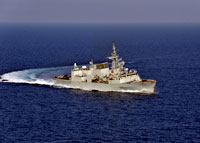
Empower yourself through change
“Awareness of change and one’s reaction to it builds resilience and empowerment,” says Marie Drapeau, strategist for Transformational Change at Assistant Deputy Minister (Human Resources – Civilian).

“Awareness of change and one’s reaction to it builds resilience and empowerment,” says Marie Drapeau, strategist for Transformational Change at Assistant Deputy Minister (Human Resources – Civilian).

You must carefully consider your option choice. At its simplest, if you do not need the cash and have enough contribution room, then rolling it into an RRSP makes sense.
Good news is on the horizon for commuters who use the soon-to-end Blue Boat internal shuttle.
[gallery] Since the beginning of the year, HMCS Oriole has been inside a giant temporary shed at Port Hope Shipyard, only a stones-throw away from Victoria’s downtown Inner Harbour and the open ocean. The longest commissioned ship in the Royal Canadian Navy is turning 91 years old this summer, and the docking work period looks to inject another nine decades of life into the historic training ship. “There is an entirely new lower half of the ship,” says LCdr Jeff Kibble, Oriole’s Captain. “So the hull plating, the ribs, the frames, effectively the lower 10 feet of the ship, or almost everything below the water line, is being replaced in its entirety.” Her keel sits atop a moveable steel grid and her hull is supported by giant wood and steel beams. Oriole is literally a shell of its former self. The engine, generator, tanks, fridges, and even sections of the two-inch thick teak deck have been removed to allow workers full access to her steel hull and frames. On the “to do” check list are painting the hull and interior shell, and repairing all underwater valves, propeller, rudder and shafts. However, the area receiving the most attention is replacing the entire keel and rusted structural supports. Glen Shippam, Oriole’s refit manager, says her age still presents unique obstacles despite many of Port Hope Shipyard workers having been involved in the ship’s refits since the 1970s and 80s. “The major challenges with working on a 91-year-old ship are getting the original drawings and then carrying out the repairs on original structures using welding procedures in lieu of rivets,” he says. “Riveting in ships has gone the way of the buggy whip and horses.” When built in the early 20th century, Oriole was pieced together using rivets. Modern ship-building techniques have long replaced rivets with welding, which is stronger and more durable. And while work periods over the past two or three decades have slowly replaced much of Oriole’s original riveted hull...
[gallery] The pipe was made, “Starboard watch, special sea-duty men, RAS teams three and five: close up for RAS with FGS Rhön! Dress: naval combat dress, negative ball caps.” Personnel from all messes in HMCS Charlottetown began to take up their positions for a “liquid RAS” — replenishment at sea with fuel — with Rhön, the German refuelling ship accompanying Standing NATO Maritime Group 1. Sailors put on their game face, for no one ever knows precisely what to expect: a calm, co-operative sea, or that stubborn windswept kind with spray tossing over the guardrails. Heavy weather can make a RAS more difficult than it already is. In my opinion, replenishment at sea is one of the riskiest things we do in a Canadian warship, and we do it all the time. On this deployment, Charlottetown is patrolling as a part of NATO task force, so we are usually at sea for more than two weeks. To keep the fuel tanks topped up, the ship needs to RAS every three to four days. To conduct a RAS, two ships with a combined mass equivalent to about 25,000 automobiles must maintain station about 50 metres apart for hours, often in difficult seas, while thousands of pounds of diesel fuel flows through 10-inch hoses suspended between them from heavy steel cables under tremendous tension. The ships are never more than a few seconds from colliding, so a mechanical failure or the smallest mistake by the bridge team could be disastrous. Nevertheless, with thoughtful preparations based on generations of experience, the crew of a Canadian warship minimizes the risk to the greatest extent possible before the refuelling ship is even in sight. The bridge team isn’t the only group with an important job to do. On the RAS deck, where it all goes down, there are many hazards that everyone must be aware of. We have to be particularly careful in the “dump” area, where the 10-inch hoses from the refuelling ship...
[gallery columns="2"] Yummy goodness arrived on base last Friday in the form of a chocolate bar wrapped with a naval image. The sweet surprise was officially launched on board HMCS Vancouver’s flight deck. Larry Sullivan, Chief Executive Officer of Rogers’ Chocolates, joined MARPAC Commander, RAdm Nigel Greenwood in unveiling the Navy’s own milk and dark chocolate bars in front of invited guests and cadets from Royal Canadian Sea Cadet Corps Rainbow. This initiative follows on the success of the commemorative HMCS Rainbow tin produced by Rogers’ Chocolates in honour of the Canadian Naval Centennial during 2010. “It’s significant that Rogers’ has chosen to perpetuate their efforts from the naval centennial and create the navy chocolate bar,” said RAdm Nigel Greenwood. The navy chocolate bar wrapper features a photo of HMCS Winnipeg exiting a small channel. This image was photographed from the ship’s Rigid Hull Inflatable Boat during a Maritime Security Patrol by CFB Esquimalt Image Technician Cpl Alex Croskery. The wrapper was graphically designed by Lookout Newspaper and Creative Services’ Shelley Fox. “We are looking forward to selling these products in our stores and giving them a high profile,” said Sullivan. “We anticipate an overwhelming level of support from the local community, but as well from the many visitors to Victoria who will be well aware of the many accomplishments of the Royal Canadian Navy.” The chocolate bars retail for $3.99 and 50 cents from each chocolate bar will be donated directly to the base morale and welfare fund. Locally, the chocolate bars will sell at Rogers’ Chocolates stores in Sidney, Saanich, Oak Bay and Government Street. Additionally, online orders can be placed at www.rogerschocolates.com Shelley Lipke, News Staff

In the final weeks of 2011, the international community’s attention was focused on North Korea.
A light morning breeze laps at the hull of HMCS Charlottetown. Thousands of miles from home, the dedicated crew, like many before them, rise and prepare for their daily watches. Thoughts of home inevitably come to mind, but they can’t dwell on them for long; their job needs to be done. This is the inevitable challenge of serving in an operational warship: balancing the imperatives of the mission with the needs of the crew. Missing home, and how people deal with missing their loved ones during a lengthy deployment, are big pieces of the puzzle. “I miss kissing my son goodnight,” says SLt Danielle Turner, who plays the dual role of mother and bridge watchkeeper. “I miss being his mom, being his hero, and giving him everything I’ve got, because I know in a short while I will be at sea again.” Regardless of occupation, we all share this burden - sailors, soldiers, airwomen and airmen. Everyone in the Canadian Forces eventually sacrifices precious time with family and friends to accomplish the mission. It’s the nature of what we do. It is important, however, to recognize that we aren’t the only ones affected by separation: our families and friends are in it with us. Our spouses miss us as much as we miss them, while also shouldering the responsibilities of the household on top of working at their own career. Service in the CF is more than a job, it’s a commitment. We make our sacrifices together, for shared purposes, and the experience binds us not just as individuals and families; but also as a crew. It is how we make up for lost time with those who matter most in our lives, and the fact that we do so collectively, that make it easier to soldier on. “I make up for lost time by writing in a journal to my son,” SLt Turner says. “Even if he doesn’t appreciate it as much as I’d want him to when he...

Kyle Croxall celebrates his victory at the Red Bull Crashed Ice World Championship 2012 in Quebec City, Canada on March 17.

HMCS Charlottetown conducts manoeuvres during Operation Active Endeavour with Standing NATO Maritime Group 1 in the Mediterranean Sea.

[caption id="attachment_305" align="alignleft" width="200" caption="You can follow Vanessa Roman on Twitter at VanessaRomanTV"][/caption]Vanessa Roman is used to seeing her husband Major Jason Roman fly off in his Sea King helicopter with the Canadian Armed Forces. But now she’s doing her own bit of moving - to the small screen. The mom of three and Halifax real estate agent hosts "Reno vs Relocate" which will begin airing on HGTV network in May. In the show, Vanessa helps families decide whether they should renovate their existing home, or find a new one. But for military families, the decision is often far more straight forward: which house will be home in a new community. The complications come from the short window in which to find property and the unique requirements for service families. Vanessa says being a Forces wife gives her first-hand experience making these moves go smoothly, and she puts in the effort to make sure that’s the case. "I come from a military family, I’m married to a military guy - so if you’re coming to Halifax, I’m the agent you need to have for your house hunting trip," says Vanessa. "I understand the challenges of moving to a new city and integrating the family within an existing community. There are a lot of hoops to jump through and you generally get just seven days to find a house." Military transfers are a unique way to move, she says, and the process can be time consuming and complicated. Vanessa is a registered real estate agent with Brookfield Global Relocation and has been through the relocation process herself. She is also an active member of the Nova Scotia Association of Realtors® and a member of the Canadian Real Estate Association. She holds degrees in Economics from Dalhousie University and Journalism from the University of King’s...

[caption id="attachment_215" align="alignright" width="200" caption="Last month, HMCS Algonquin participated in a series of exercises off Southern California with U.S. and Mexican naval assets."][/caption]Story By: Lt(N) Mike Ronaldson, HMCS Algonquin In mid-February, HMCS Algonquin took part in the North American Maritime Security Initiative (NAMSI) exercise off the coast of Southern California and Northern Mexico. NAMSI is an interagency tri-lateral security initiative between the U.S., Canadian, and Mexican maritime commands. The primary goal of the exercise was to test the interoperability and mutual understanding amongst the participating commands. The Feb. 22-23 exercise was conducted to validate the tri-lateral agreement’s standard operating procedures (SOP) used to coordinate the hand over of custody of a suspect vessel from one nation to another. The procedures are designed to facilitate maritime law enforcement as it relates to interdicting vessels suspected of trafficking illicit drugs or other illegal activities prohibited by international law. The exercise was also an opportunity to observe and learn from how the U.S. and Mexico conduct boarding operations. The first day had Algonquin’s boarding team board the U.S. tanker, USNS Henry J. Kaiser, who was playing the role of the merchant vessel Black Pearl, a container ship known to be harboring a person of interest with links to terrorist activity. After obtaining permission from Canadian maritime authorities, Algonquin’s Naval Boarding Party secured the vessel and conducted a search for the potential terrorist. Once the person was located, secured and his identity confirmed, U.S. national authorities were contacted in order to turn over the custody of the vessel to the United States. Shortly after national maritime authorities had completed the requisite paperwork, USCGC Boutwell was seen charging over the horizon in order to take custody of the Black Pearl and the person of interest. Algonquin’s Naval Boarding Party officer and his team conducted a thorough...

[caption id="attachment_211" align="alignright" width="200" caption="The Blue Boat cross-harbour ferry service will cease operations as of April 30, 2012."][/caption]The Blue Boats have satisfied many requirements to transport military members and DND civilian employees across Esquimalt Harbour over the past 50 years. Come the end of April, the venerable vessels will start a new chapter when their most recent role as scheduled shuttles will end. The Auxiliary Fleet responsible for the boats’ operations is currently facing staffing challenges. The section is comprised of qualified ship’s officers, ship’s engineers and Deckhands that operate a range of vessels using a manning pool concept. As personal resources have become more constrained, it has become increasingly challenging for the Auxiliary Fleet to meet all of its operational commitments in addition to providing the cross-harbour service. By the end of April, given scheduling, leave, medical and all the other demands placed on personnel, it simply was not going to be acceptable to continue with the cross-harbour service while not having critically important Tugs and Barges available for operational support. The primary task for the Blue Boats has been to connect Defence properties and organizations along the harbour in order to facilitate the performance of official duties. In recent years, an increasing number of people living in Colwood and the West Shore have availed themselves of the service to shorten or improve their travel to and from work. This was not a mandate of the Blue Boats but was perceived as such given the number of people who took advantage of this extra-capacity during commuting hours. Capt(N) Craig Baines, Base Commander of CFB Esquimalt, says while he is certainly sympathetic that the change will impact the 300 to 400 daily commuters that catch the Blue Boat each day, the Auxiliary Fleet have nevertheless exhausted their ability to both...

[caption id="attachment_208" align="alignright" width="200" caption="RAdm Nigel Greenwood, Commander Maritime Forces Pacific, and Cdr David Mazur, Commanding Officer of HMCS Vancouver, are joined by Darren Parker, Royals’ Senior Vice President Sales and Marketing, at centre ice for the puck drop."][/caption]Story By: Base Public Affairs A week ago, the largest arena in Victoria was brimming with hockey fans, including a large contingent from CFB Esquimalt. Military members were the special guests of the Victoria Royals, the city’s Western Hockey League team, during their March 3 game against the Vancouver Giants at the Save-on-Foods Memorial Centre. Front and centre in the military appreciation night were sailors from HMCS Vancouver, freshly back from seven months in the Mediterranean enforcing United Nation’s imposed arms embargo against Libya. The Royals also donated more than 150 free tickets, which were given to deserving personnel from the Formation, and discounted general tickets for CF members and their families. As hockey fans arrived at the Memorial Centre, they were able to check out the Fleet Dive Unit bomb disposal truck and see the bomb disposal robot in action. They also received a CF promotional item as a souvenir of the evening. The pre-game show was all about the Canadian Forces. Vancouver crew members formed the Flag Party on the ice while the Naden Band performed the national anthem. At the conclusion of ‘Oh Canada”, a locally produced DND video highlighting all three elements of the CF played on the megatron screens as announcer Cliff Lequesne talked about the work done by the CF. To the delight and surprise of the crowd, three search and rescue technicians from 442 Squadron Comox, hiding in the rafters, repelled down to the ice to hand deliver the ceremonial puck to Marty the Marmot. “It is very special to rappel from the roof and land...